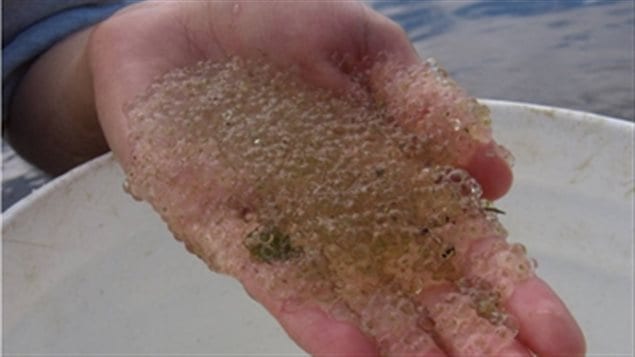Decades ago sulphourus pollution from industrial smoke stacks floating in the air ended up aborbed in water molecules and falling as acidic rain. Action was taken to greatly curb those pollutants, but now, although greatly reduced, the legacy of acid rain has revealed a subsequent lingering effect.
Lakes in central Ontario, once greatly affected by acid rain, are showing signs of “jellification”.
It seems the acidic rain was reducing the calcium level in lakes all across the Canadian shield. While all organisms need calcium to survive, crustaceans need it even more to build protective shells.
Scientists have now discovered that a tiny crustacean, a crucial component at the bottom of the freshwater food chain, Daphia, (“water fleas”), are slowly disappearing due to lack of calcium which is vital to form their protective shells.
“Osteoporosis” of the lakes
Citing similarities to the condition of osteoporosis, John Smol, who holds the Canada Research Chair in Environmental Change at Queen’s University in Kingston, Ontario says, Daphia with their high calcium needs, are losing out to a very low calcium needs competitor, Holopedia, which has a jelly coating. That jelly coating also helps protect it from predators that feed on plankton of this size.
Professor Smol is co-author of a report recently published in the journal Proceedings of the Royal Society B-
The population of these tiny invertebrate “jellies” has more than doubled in the last 20 years. Researchers say that will prevent vital nutrients from being passed up the food chain to fish stocks.
The increase in Holopedia, creating a tapioca like goo, could also clog water filtration systems. In Ontario, Canada’s most populous province, 20 percent of government-monitored drinking water now comes from areas with depleted calcium lakes.
Calcium normally leaches slowly into lakes through run off passing through soil and fallen trees. But the acid rain stripped out most of the readily available calcium in a few short decades, leaving little for future years. Timber harvesting also removes a source of calcium.
Calcium loss isn’t the only bad news for Daphniids. The team suggests that climate change is causing oxygen decline deep in the lakes, creating better conditions and increasing populations of larval midges – the main predator of Daphnia. They are also profiting from Daphnia’s now smaller size and weaker shells.
The researchers examined sediment cores from the bottom of 38 lakes across south-central Ontario, with preserved exoskeletons dating from pre-1850 to present. They also examined Holopedia levels in dozens of lakes in east coast Nova Scotia and found a similar rise in the jelly-covered plankton. This suggests that geologically similar lake regions across eastern Canada, the US New England states and right to Scandinavia could be similarly affected







For reasons beyond our control, and for an undetermined period of time, our comment section is now closed. However, our social networks remain open to your contributions.